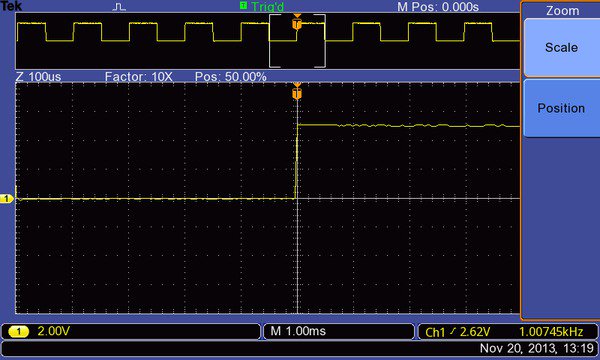
Contact us
Live Chat with Tek representatives. Available 6:00 AM - 4:30 PM
Call us at 1-800-833-9200
Available 6:00 AM – 5:00 PM (PST) Business Days
Download
Download Manuals, Datasheets, Software and more:
Feedback
Digital Storage Oscilloscope
TBS1000B-EDU Series Datasheet
The products on this datasheet are no longer being sold by Tektronix.
View Tektronix Encore for reconditioned test equipment.
Check support and warranty status for these products.
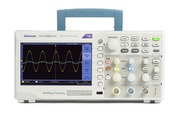
The TBS1000B-EDU Digital Storage Oscilloscope Series is designed specifically to meet the needs of today's schools and universities. It's the first oscilloscope to use an innovative new Courseware system that enables educators to seamlessly integrate teaching materials onto TBS1000B-EDU oscilloscopes. The Courseware information is presented directly on the oscilloscope display and can be used to provide; step by step instructions, background theory, hints and tips or an efficient way for students to document their lab work. The instrument includes a 7-inch WVGA TFT color display, up to 2 GS/s sampling rate, bandwidths from 70 MHz to 200 MHz, dual channel frequency counters and a 5 year standard warranty, just a few of the features that make the TBS1000B-EDU the industry's best-value entry level oscilloscope for educational activities.
Key performance specifications
200 MHz, 150 MHz, 100 MHz, and 70 MHz bandwidth models
- 2-channel models
Up to 2 GS/s sample rate on all channels
- 2.5k point record length on all channels
- Advanced triggers including pulse and line-selectable video triggers
Key features
7 inch WVGA (800X480) Active TFT Color Display
34 automated measurements
- Dual window FFT, simultaneously monitors both the time and frequency domains
- Integrated Courseware feature
- Dual channel frequency counter
- Zoom Function
- Autoset and signal auto-ranging
- New affordable 50 MHz TPP0051 passive probes
- Multiple-language user interface
- Small footprint and lightweight - Only 4.9 in. (124 mm) deep and 4.4 lb. (2 kg)
Connectivity
- USB 2.0 host port on the front panel for quick and easy data storage
- USB 2.0 device port on rear panel for easy connection to a PC
Seeing signal details
To properly analyze signals you need to make sure that you can see them in enough detail. The TBS1000B-EDU comes standard with a 7-inch high resolution TFT display for a clear view of all of your signals and critical on screen information. The instrument is further enhanced by a user interface inspired by the award winning Tektronix MSO/DPO series of instruments. The interface is easy to use, provides quick access to all of the oscilloscope functions and includes a high resolution "Pan & Zoom" feature enabling you to see even more signal details of up to 10 times normal resolution.

The zoom function shows details in an event of up to 10X the normal view.
Digital precision for accurate measurements
With up to 200 MHz bandwidth, 2 GS/s maximum sample rate and 3% vertical measurement accuracy the oscilloscope allows you to see all of your signals details. With the Tektronix proprietary sampling technology there are no compromises, you will get the stated real-time sampling rate on all channels, all the time with at least 10X oversampling. The sampling performance is not reduced when changing horizontal settings or when using multiple channels, enabling you to see the true characteristics of your signals.
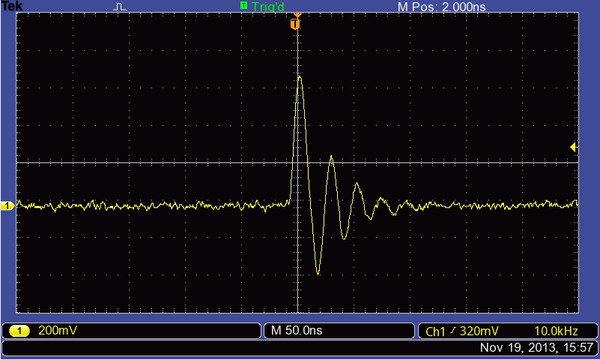
See all the details other oscilloscopes might miss with Tektronix proprietary digital real- time sampling.
Critical tools for troubleshooting your device
The TBS1000B-EDU oscilloscope enables students to learn about the advanced triggers used to debug today's complex circuitry. Standard rising or falling edge, pulse width and video trigger set-ups will allow students to quickly isolate signals of interest and investigate alternative triggering options using the flexible trigger set-up menus.

The pulse trigger function can easily capture critical events.
Once signals are captured, the TBS1000B-EDU offers advanced math and measurement capabilities making it easy to evaluate signal quality . Users can quickly add, subtract and multiply waveforms or use any one of 34 automated measurements to quickly and reliably calculate important signal characteristics such as frequency, rise time or overshoot.
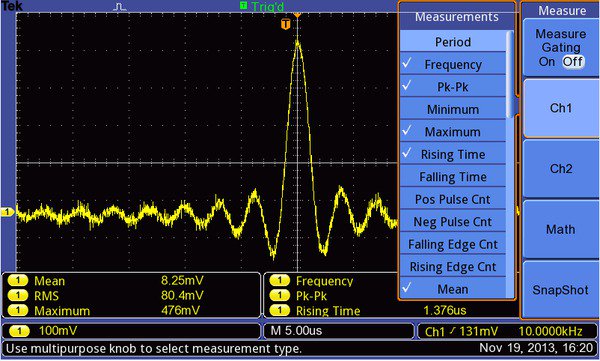
Quickly analyze signals with the standard 34 automated measurements.
For advanced frequency analysis, a dedicated front panel button provides quick access to the FFT function that can show both frequency and time domain waveforms simultaneously, providing the student with a convenient way to understand the relationship between their signals and the FFT results.
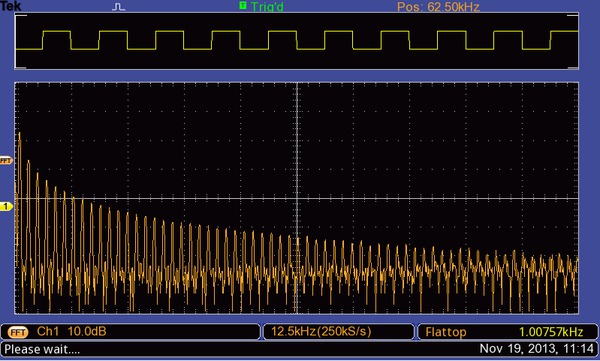
Quickly perform an FFT with a dedicated front panel button.
To further enhance the teaching process, the oscilloscopes "Autoset" function can be disabled. For those beginning labs where it is important for a student to learn the basic operation of the oscilloscope, disabling Autoset will help them apply their knowledge of an oscilloscope's operation instead of taking shortcuts with the Autoset button. This feature is password controlled so Autoset can be disabled or enabled by accessing the Autoset screen in the Utility menu.
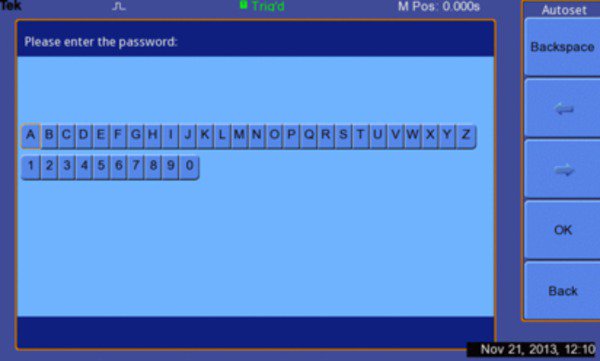
The "Autoset" function can be disabled or enabled by entering a password in the Utility menu.
The TBS1000B-EDU also comes with built-in dual channel frequency counters. Independent control of each counter's trigger level provides an easy way to monitor two different signal frequencies simultaneously.
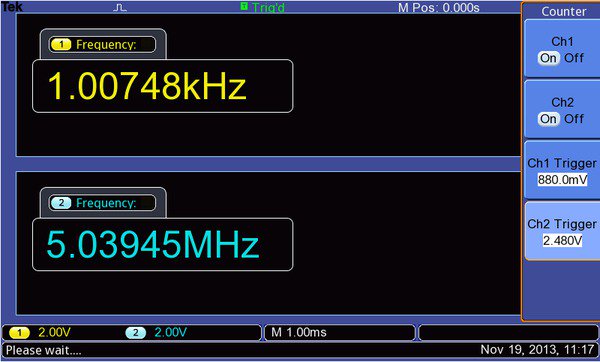
Dual channel - 6 digit frequency counters come standard with all TBS1000B-EDU models.
Courseware feature
The innovative Courseware feature sets up an education ecosystem by combining powerful PC Course Editor software with the TBS1000B-EDU instruments and a Courseware landing page. The new feature gives educators the ability to create lab descriptions and instructions and then upload the material directly onto a TBS1000B-EDU oscilloscope. Existing labs can be modified with content that directly supports recent lectures or explores new ideas discovered in class discussions. Students can perform their lab work directly on the oscilloscope and record their progress in a report file consisting of oscilloscope screen captures. Courseware materials can easily be shared between different labs, professors at the same institution or even between educators from around the world. The Tektronix Courseware Web Page is set up to make it easy for educators to share their own course material or get inspired by reviewing new and interesting ideas from their peers.

PC Course Editor software
It all starts with the PC Courseware editor tool. This Windows based application provides the framework in which the courseware is developed. With simple Windows tools instructors can create new labs or edit existing labs using text, images, formulas or tables. A profile signature can also be created that identifies the professor, class or school.
The basic building block of the Courseware content is the Lab section. An overview, equipment set-ups, theory discussions and step by step instructions can all be included in this section. When the labs are completed a course can be created. In general, a course is made up of several labs with related topics, for example a basic digital course may consist of lab topics that include; "Basic Boolean Logic", "Simple AND & OR Gates", "Clocks", "Metastable Devices", "Memory Devices", etc. Individual Labs can be shared among multiple courses enabling professors to cater course material to a specific audience. Once all of the courses are defined a package/workspace file is created which contains all of the courses with their related labs and enables the content to be uploaded onto a TBS1000B-EDU oscilloscope.
To accommodate regional differences the Courseware PC software and the help wizard support is available in 11 different languages.
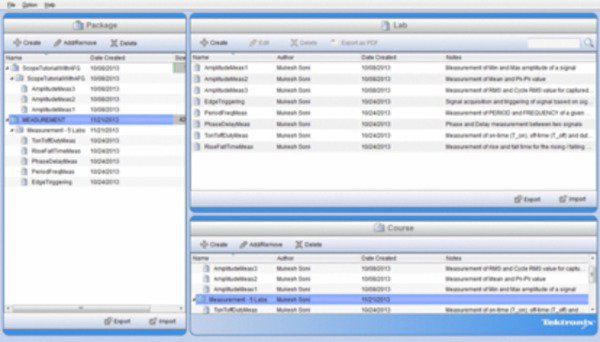
The Courseware PC interface uses Labs to build courses. The courses are then used to build packages which are uploaded to the oscilloscope.
The oscilloscope courseware features
When the workspace file is loaded onto an instrument, students can easily access the content by using the dedicated "Course" button located on the front panel. Using the oscilloscopes soft keys and the multipurpose knob, students can access up to 8 courses which can have up to 30 labs each. To accommodate situations where and instrument is used for several classes, up to 100 MB of course material can be stored on the oscilloscope. Once a lab is chosen, the student is able to review the overview section, perform the lab using the step-by-step procedure, collect data, check & save the data results and generate reports that show the waveforms created for each step in the procedure. And all of this work can be done directly on the oscilloscope.
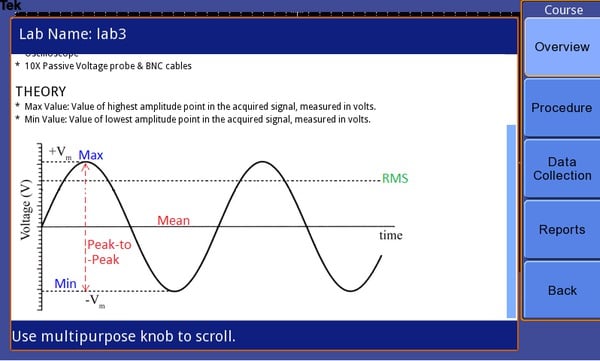
The Courseware menus accessed by the oscilloscope soft keys provide easy access to all of the Courseware features.
Tektronix Courseware landing page
To help educators find new and interesting ideas for creating content for their labs Tektronix has created a Courseware Web page. At this site, users can download and customize relevant course material or upload material to share their own labs with peers. The site also contains a comprehensive search engine that allows visitors to search for labs by key word, author, category, topic and/or language. Although registration for the site is required, once registered, users are able to download or upload material and they will also be able to comment on material that they've used.
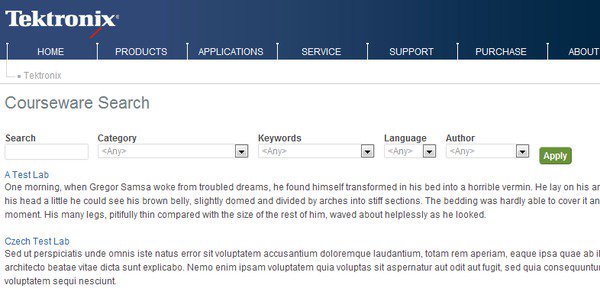
A powerful search engine makes is easy to find material of interest.
Designed to make your work easy
The TBS1000B-EDU series oscilloscopes are designed with the ease of use and familiar operation you have come to expect from Tektronix.
Intuitive operation
The intuitive user interface with dedicated per-channel vertical controls, zoom/magnifier button and convenient access to functions using the oscilloscope's soft keys and multi-purpose knob make these instruments easy to use, reducing learning time and increasing efficiency.
Help when you need it where you need it
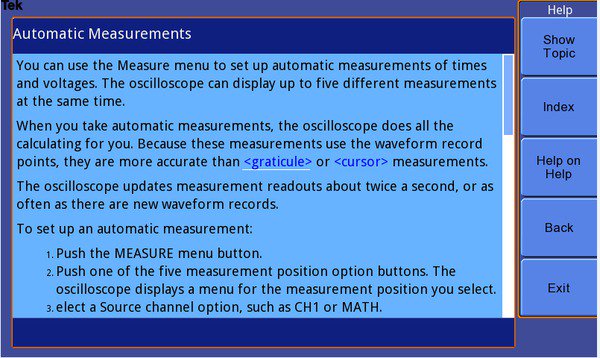
The context-sensitive help system provides important information specific to the task you are working on.
The built-in Help menu provides you with important information about your oscilloscope's features and functions. Help is provided in the same languages as the user interface.
Performance you can count on
In addition to industry-leading service and support, every TBS1000B-EDU series oscilloscope comes backed with a standard 5-year warranty.
Specifications
All specifications are guaranteed unless noted otherwise. All specifications apply to all models unless noted otherwise.
Model overview
| TBS1072B-EDU | TBS1102B-EDU | TBS1152B-EDU | TBS1202B-EDU | |
|---|---|---|---|---|
| Bandwidth | 70 MHz | 100 MHz | 150 MHz | 200 MHz |
| Channels | 2 | 2 | 2 | 2 |
| Sample rate on each channel | 1.0 GS/s | 2.0 GS/s | 2.0 GS/s | 2.0 GS/s |
| Record length | 2.5k points at all-time bases | |||
Vertical system – Analog channels
- Vertical resolution
- 8 bits
- Input sensitivity range
- 2 mV to 5 V/div on all models with calibrated fine adjustment
- DC gain accuracy
- ±3%, from 10 mV/div to 5 V/div
- Maximum input voltage
- 300 VRMS CAT II; derated at 20 dB/decade above 100 kHz to 13 Vp-p AC at 3 MHz and above
- Offset range
2 mV to 200 mV/div: ±1.8 V
>200 mV to 5 V/div: ±45 V
- Bandwidth limit
- 20 MHz
- Input coupling
- AC, DC, GND
- Input impedance
- 1 MΩ in parallel with 20 pF
- Vertical zoom
- Vertically expand or compress a live or stopped waveform
Horizontal system — Analog channels
- Time base range
- 30 MHz model1
- 10 ns to 50 s/div
- 50 MHz and 70 MHz models
- 5 ns to 50 s/div
- 100MHz, 150MHz and 200MHz models
- 2.5 ns to 50 s/div
- Time base accuracy
- 50 ppm
- Horizontal zoom
- Horizontally expand or compress a live or stopped waveform
Input/Output ports
- USB interface
USB host port on front panel supports USB flash drives
USB device port on back of instrument supports connection to PC
- GPIB interface
- Optional
Data storage
- Nonvolatile storage
- Reference waveform display
- 2.5K point reference waveforms
- Waveform storage without USB flash drive
- 2.5K point
- Maximum USB flash drive size
- 64 GB
- Waveform storage with USB flash drive
- 96 or more reference waveforms per 8 MB
- Setups without USB flash drive
- 10 front-panel setups
- Setups with USB flash drive
- 4000 or more front-panel setups per 8 MB
- Screen images with USB flash drive
- 128 or more screen images per 8 MB (the number of images depends on file format selected)
- Save All with USB flash drive
- 12 or more Save All operations per 8 MB
A single Save All operation creates 3 to 9 files (setup, image, plus one file for each displayed waveform)
- Course content
100 MB
Acquisition system
- Acquisition modes
- Peak Detect
- High-frequency and random glitch capture. Captures glitches as narrow as 12 ns (typical) at all time base settings from 5 μs/div to 50 s/div
- Sample
- Sample data only
- Average
- Waveform averaged, selectable: 4, 16, 64, 128
- Single Sequence
- Use the Single Sequence button to capture a single triggered acquisition sequence
- Roll
- At acquisition time base settings of >100 ms/div
Trigger system
- External trigger input
- Included on all models
- Trigger modes
- Auto, Normal, Single Sequence
- Trigger types
- Edge (Rising/Falling)
- Conventional level-driven trigger. Positive or negative slope on any channel. Coupling selections: AC, DC, Noise Reject, HF Reject, LF Reject
- Video
- Trigger on all lines or individual lines, odd/even or all fields from composite video, or broadcast standards (NTSC, PAL, SECAM)
- Pulse Width (or Glitch)
- Trigger on a pulse width less than, greater than, equal to, or not equal to, a selectable time limit ranging from 33 ns to 10 s
- Trigger source
- Two channel models: CH1, CH2, Ext, Ext/5, AC Line
- Trigger view
- Displays trigger signal while Trigger View button is depressed.
- Trigger signal frequency readout
- Provides a frequency readout of the trigger source.
Waveform measurements
- Cursors
- Types
- Amplitude, Time
- Measurements
- ΔT, 1/ΔT, ΔV
- Automatic measurements
Period, Frequency, Pos Width, Neg Width, Rise Time, Fall Time, Maximum , Minimum , Peak-Peak, Mean, RMS, Cycle RMS, Cursor RMS, Phase, Pos Pulse Cnt, Neg Pulse Cnt, Rise Edge Cn, Fall Edge Cn, Pos Duty, Neg Duty, Amplitude, Cycle Mean, Cursor Mean, Burst Width, Pos Overshoot, Neg Overshoot, Area, Cycle Area, High, Low, Delay RR, Delay RF, Delay FR, Delay FF
Waveform math
- Arithmetic
- Add, Subtract, Multiply
- Math functions
- FFT
- FFT
- Windows: Hanning, Flat Top, Rectangular
- Sources
- Two channel models: CH1 - CH2, CH2 - CH1, CH1 + CH2, CH1 × CH2
Autoset menu
Single-button, automatic setup of all channels for vertical, horizontal, and trigger systems, with undo autoset.
- Square wave
- Single cycle, multicycle, rising or falling edge
- Sine wave
- Single cycle, multicycle, FFT spectrum
- Video (NTSC, PAL, SECAM)
- Field: All, Odd, or Even Line: All or Selectable Line Number
Autorange
- Automatically adjust vertical and/or horizontal oscilloscope settings when probe is moved from point to point, or when the signal exhibits large changes.
Frequency counter
- Resolution
- 6 digits
- Accuracy (typical)
- + 51 parts per million including all frequency reference errors and +1 count errors
- Frequency range
- AC coupled, 10 Hz minimum to rated bandwidth
- Frequency counter signal source
Pulse width or edge selected trigger source
Frequency counter measures selected trigger source at all times in pulse width and edge mode, including when the oscilloscope acquisition is halted due to changes in run status, or acquisition of a single shot event has completed.
The frequency counter does not measure pulses that do not qualify as legitimate trigger events.
Pulse Width mode: Counts pulses of enough magnitude inside the 250 ms measurement window that qualify as triggerable events (e.g. all narrow pulses in a PWM pulse train if set to "<" mode and the limit is set to a relatively small number).
Edge Trigger mode: Counts all pulses of enough magnitude.
- Channels
- 2 channel
Display system
- Interpolation
- Sin (x)/x
- Waveform styles
- Dots, vectors
- Persistence
- Off, 1 s, 2 s, 5 s, infinite
- Format
- YT and XY
Courseware software
- System requirements
The following PC configuration represents the minimum requirements needed to install the Courseware software.
Operating System Windows XP, Windows 7, Windows 8, Linux (ubuntu 12.04, 12.10, 13.04 or fedora 18, 19) RAM 512 Megabytes (MB) Disk space 1 Gigabyte of available hard disk space Display XVGA 1024×768 with 120 dpi font size recommended Removable media CD-ROM or DVD drive Peripherals Keyboard and Microsoft mouse or other compatible pointing device
Power source
- Power source voltage
- 100 to 240 V ±10%
- Power source frequency
- 100 V to 240 V
- 50 Hz to 60 Hz
- 115 V
- 400 Hz ±10%
- Power consumption
- 30 W maximum
Physical characteristics
- Dimensions
mm in. Height 158.0 6.22 Width 326.3 12.85 Depth 124.2 4.89
- Shipping dimensions
mm in. Height 266.7 10.5 Width 476.2 18.75 Depth 228.6 9.0
- Weight
kg lb. Instrument only 2.0 4.3 ...with accessories 2.2 4.9
- RM2000B rackmount
mm in Width 482.6 19.0 Height 177.8 7.0 Depth 108.0 4.25
Environmental
- Temperature
- Operating
- 0 to +50 ºC
- Nonoperating
- –40 to +71 ºC
- Humidity
- Operating and nonoperating
Up to 85% RH at or below +40 ºC
Up to 45% RH up to +50 ºC
- Altitude
- Operating and nonoperating
- Up to 3,000 m (9,843 ft.)
- Regulatory
- Electromagnetic compatibility
- Meets Directive 2004/108/EC, EN 61326-2-1 Class A; Australian EMC Framework
- Safety
- UL61010-1:2004, CSA22.2 No. 61010-1:2004, EN61010-1:2001, IEC61010-1:2001
Ordering information
Models
- TBS1072B-EDU
70 MHz, 2 Ch, 1 GS/s, TFT DSO
- TBS1102B-EDU
100 MHz, 2 Ch, 2 GS/s, TFT DSO
- TBS1152B-EDU
150 MHz, 2 ch, 2 GS/s, TFT DSO
- TBS1202B-EDU
200 MHz, 2 ch, 2 GS/s, TFT DSO
Instrument options
Language options
- Opt. L1
- French overlay
- Opt. L2
- Italian overlay
- Opt. L3
- German overlay
- Opt. L4
- Spanish overlay
- Opt. L5
- Japanese overlay
- Opt. L6
- Portuguese overlay
- Opt. L7
- Simplified Chinese overlay
- Opt. L8
- Traditional Chinese overlay
- Opt. L9
- Korean overlay
- Opt. L10
- Russian overlay
Power plug options
- Opt. A0
- North America power plug (115 V, 60 Hz)
- Opt. A1
- Universal Euro power plug (220 V, 50 Hz)
- Opt. A2
- United Kingdom power plug (240 V, 50 Hz)
- Opt. A3
- Australia power plug (240 V, 50 Hz)
- Opt. A4
- North America power plug (240 V, 50 Hz)
- Opt. A5
- Switzerland power plug (220 V, 50 Hz)
- Opt. A6
- Japan power plug (100 V, 50/60 Hz)
- Opt. A10
- China power plug (50 Hz)
- Opt. A11
- India power plug (50 Hz)
- Opt. A12
- Brazil power plug (60 Hz)
- Opt. A99
- No power cord
Service options
- Opt. D1
- Calibration Data Report
Probes and accessories are not covered by the oscilloscope warranty and Service Offerings. Refer to the datasheet of each probe and accessory model for its unique warranty and calibration terms.
Probe option
- TBS1XX2B-EDU P2220
- Replaces standard probes with P2220 probes (200 MHz passive voltage probes with 1x/ 10x attenuation)
Accessories
Standard accessories
| Accessory | Description |
|---|---|
| Passive probes, one per channel | TPP0101: 100 MHz passive probe for: TBS1072B-EDU, TBS1102B-EDU |
| TPP0201: 200 MHz passive probe for: TBS1152B-EDU, TBS1202B-EDU | |
| Power cord | (Please specify plug option) |
| NIM/NIST | Traceable certificate of calibration |
| Printed documentation | Installation and safety manual |
| (English, Japanese, and Simplified Chinese) | |
| CD with customer documentation and software | Customer documentation including detailed user manuals (English, French, German, Italian, Japanese, Korean, Portuguese, Russian, Simplified Chinese, Spanish, Traditional Chinese), Courseware PC Software, example Courseware labs, ABC's of Probes application note, XYZ's of Oscilloscopes application note, Courseware PC Software download link, www.tek.com Education landing page |
| 5-year warranty | Covers labor and parts for defects in materials and workmanship for 5 years, excluding probes and accessories (probes and accessories are not covered by the oscilloscope warranty and service offerings. refer to the data sheet of each probe and accessory model for its unique warranty and calibration terms) |
Recommended accessories
| Accessory | Description |
|---|---|
| TEK-USB-488 | GPIB-to-USB converter |
| AC2100 | Soft carrying case for instrument |
| HCTEK4321 | Hard plastic carrying case for instrument (requires AC2100) |
| RM2000B | Rackmount kit |
| 077-0444-xx | Programmer manual – English only |
| 077-0897-xx | Service manual – English only |
| 174-4401-xx | USB host to device cable, 3 ft. long |
Recommended probes
| Probe | Description |
|---|---|
| TPP0051 | 10X passive probe, 50 MHz bandwidth |
| TPP0101 | 10X passive probe, 100 MHz bandwidth |
| TPP0201 | 10X passive probe, 200 MHz bandwidth |
| P2220 | 1X/10X passive probe, 200 MHz bandwidth |
| P6101B | 1X passive probe (15 MHz, 300 V RMS CAT II rating) |
| P6015A | 1000X high-voltage passive probe (75 MHz) |
| P5100A | 100X high-voltage passive probe (500 MHz) |
| P5200A | 50 MHz, 50X/500X high-voltage differential probe |
| P6021A | 15 A, 60 MHz AC current probe |
| P6022 | 6 A, 120 MHz AC current probe |
| A621 | 2000 A, 5 to 50 kHz AC current probe |
| A622 | 100 A, 100 kHz AC/DC current probe/BNC |
| TCP303/TCPA300 | 150 A, 15 MHz AC/DC current probe/amplifier |
| TCP305A/TCPA300 | 50 A, 50 MHz AC/DC current probe/amplifier |
| TCP312A/TCPA300 | 30 A, 100 MHz AC/DC current probe/amplifier |
| TCP404XL/TCPA400 | 500 A, 2 MHz AC/DC current probe/amplifier |




